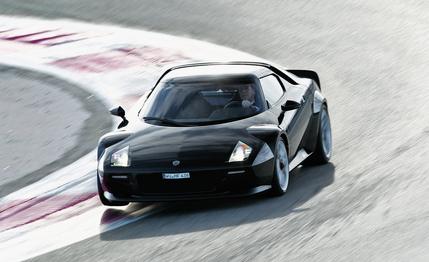
 First Drive Review
First Drive Review
In the summer of 2002, Chris Hrabalek, an Austrian automotive designer, sees a Ferrari Dino 246GT stranded on a Spanish road close to Sitges. Hoping to lend a hand, Hrabalek gets out and introduces himself to the driver, German Michael Stoschek. They start working on the Dino. They get to talking. It turns out that the men share something beyond the breakdown lane on the road to Sitges: namely, a passion for the Lancia Stratos HF rally car of the ’70s. In fact, they had met once before, at a Stratos convention in 1986. Hrabalek was nine years old.
The two keep in touch. Hrabalek sends Stoschek the sketches of a modern Stratos interpretation he’s been working on. Stoschek, CEO and owner of the successful German automotive supplier Brose, and a passionate driver of historic rally cars, begins to dream. This is what is known as serendipity.
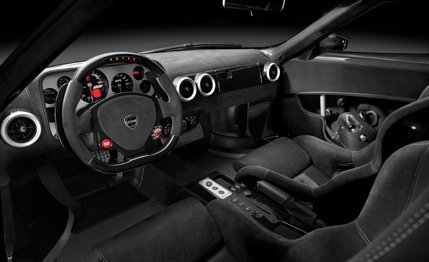

Three years later, the concept version of Hrabalek’s Stratos sits on its own stand at the 2005 Geneva show, wearing the badge Fenomenon Stratos. It’s a sensation. Stoschek declares, “We have to build this car!” and spends the next three years putting together construction and financial plans. In September 2008, six years to the month that he met Hrabalek on that Spanish road, Stoschek signs a contract with Pininfarina to build a one-off Stratos on a cut-down Ferrari 430 Scuderia. Two years, two months, and a rumored 3 million euros later, the so-called New Stratos is ripping a tidy little hole through the atmosphere at France’s Paul Ricard circuit. We’re up next to drive it.
There’s a nice historical symmetry to the mechanicals: The original Lancia Stratos HF was powered by the V-6 engine from a Ferrari Dino 246GT like the one Stoschek was driving when he and Hrabalek met in Spain; the New Stratos uses the Ferrari Scuderia’s 4.3-liter V-8. It is mounted on a steel subframe and built into a shortened version of the Scuderia’s aluminum chassis. Pininfarina took out 7.9 inches just ahead of the B-pillars and added a stout, 121-pound steel-tube roll cage. The wheelbase shrunk to 94.5 inches; the New Stratos checks in at 77.6 inches wide, 48.8 inches high, and just 164.6 inches in overall length. All exterior body parts (and most of the interior bits) are carbon fiber, as keeping mass in check was a priority. In total, Pininfarina managed to shave 176 pounds from the Scuderia, despite the addition of the roll cage. An example: The 9.3-pound battery is a lithium-ion unit housed inside a carbon-fiber box.
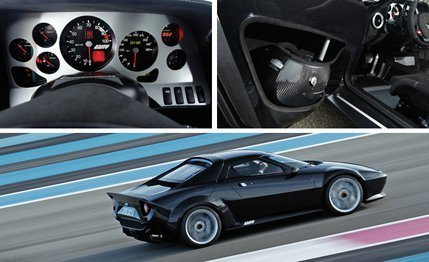

Instead of jumping behind the steering wheel, I have to carefully twist my body, racing-style, into the leather-coated carbon-fiber bucket. These seats are only 14.6 inches wide, which severely limits the body types able to drive the car. Most non-vegans and nearly all automotive journalists won’t make it. The dashboard is unique to the car—it’s not simply a 430 instrument panel bolted into place—and it features custom Ferrari gauges. Pininfarina shaped the bottom of the steering wheel flat, but the start button, manettino, paddle shifters, and gearbox controls for the six-speed “F1” automated manual are original Ferrari parts. I close the door and find my helmet stored in a specially designed compartment in the door panel.
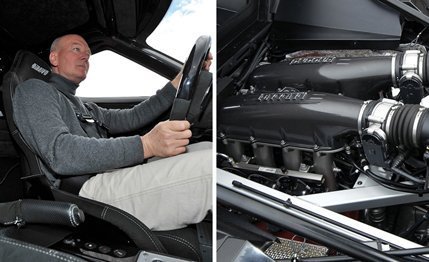

And when the engine comes alive, it barks, screams, and whimpers like, well, like a Ferrari flat-plane-crank V-8. Off we go, plunging down the straight at Paul Ricard in fourth gear, pushing the Brembo carbon-ceramic brakes hard, downshifting to second and turning into the first hard right. If you’ve ever wondered what a 430 Scuderia would be like with even less weight, more noise, and a shorter wheelbase, here’s the snapshot: Synaptic throttle response, daggerlike electrohydraulic steering; instantaneous downshifts; punishing braking forces. This car is Tony Stark’s flying suit. It is incredibly, precisely balanced, with a stiffer tune to the Ferrari’s ZF/Sachs dynamic dampers and more aggressive alignment settings. Stoschek mentions a 44/56 front-to-rear weight distribution, and we believe him, even if understeer is easily provoked in tight corners. But as soon as I jump on the throttle, the New Stratos’s rear end tries to beat its front to the corner exit. I react quickly enough to just catch it.
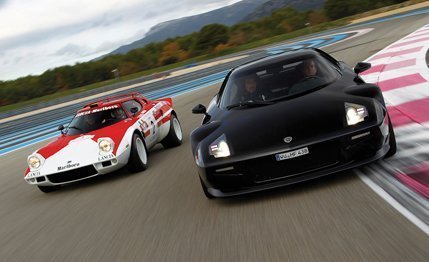

And here is the main difference between the Stratos and the heavier Scuderia: To cut 176 pounds and to help the car leap out of corners, Pininfarina’s prototype workshop replaced the active Ferrari E-Diff with a sharper-reacting, lightweight Drexler limited-slip differential that sends a wallop of torque to both rear wheels. Thanks to the high-performance exhaust system, engine output jumps to 533 horsepower at 8200 rpm. This addition of 30 horses might not seem like much, but it is acting upon a waiflike, 2900-pound curb weight. (Compare 5.4 pounds per horsepower for the Stratos with 6.1 for the 430 Scuderia.) The two-seater should accelerate from 0 to 60 mph in 3.2 seconds and reach a quarter-mile in 11.3 seconds. Maximum speed is 168 mph. “We don’t want to be the best in top speed but in handling behavior,” says Stoschek.
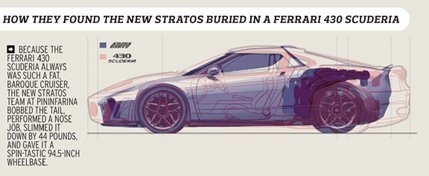

Rest assured that the principals here aren’t going to let this project retreat into one enthusiast’s garage, no matter how high-profile he may be. Stoschek is investigating building a very limited series of the New Stratos. “The tools are good enough for 25 more units,” Stoschek says. “For about 600,000 euros apiece, Pininfarina probably could build it. I won’t become a car manufacturer. I am just keeping the copyright.” Then he drops the bomb: “The New Stratos can be built on a Ferrari 458 Italia base as well.”
Any Italia owners man enough to want in? You can find Stoschek on the road to Sitges.